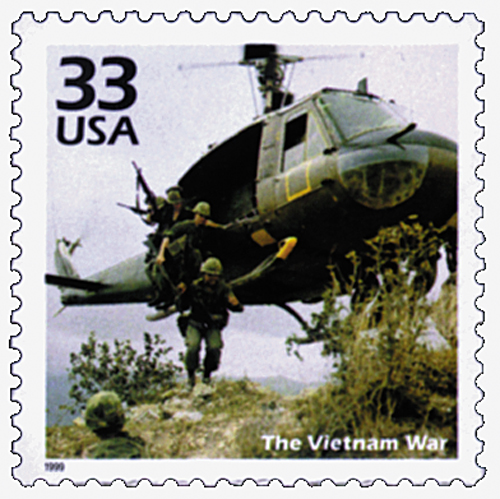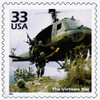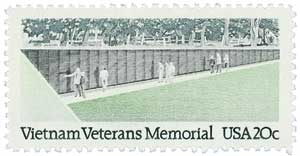
# 3188g - 1999 33c Celebrate the Century - 1960s: The Vietnam War
37¢ Viet Nam War
Celebrate the Century – 1960s
City: Green Bay, WI
Quantity: 8,000,000
Printing Method: Lithographed, engraved
Perforations: 11.5
Dedication Of Vietnam Veterans Memorial
In the 1950s, Vietnam was divided along the 17th parallel, into communist North and anti-communist South Vietnam. Following the assassination of the president of South Vietnam, a period of political instability began, while military generals fought for control of the government.

The number of American advisors in Vietnam grew, and by the end of 1963, there were 16,000 US military personnel in Vietnam. That number increased significantly after the Gulf of Tonkin Resolution, which gave President Johnson the power to increase the country’s involvement in Vietnam without declaring war.
By the end of 1966, there were 400,000 Americans fighting in Vietnam. Peace talks began in 1968, but were repeatedly stalled. After Richard Nixon took office as US president in 1969, he began Vietnamization, to remove American troops and leave the fighting to the South Vietnamese. The last Americans left Vietnam in 1973, and the war continued until the fall of Saigon two years later. Vietnam was reunited as the Socialist Republic of Vietnam in 1976.
Click here to see video from the dedication ceremony.
37¢ Viet Nam War
Celebrate the Century – 1960s
City: Green Bay, WI
Quantity: 8,000,000
Printing Method: Lithographed, engraved
Perforations: 11.5
Dedication Of Vietnam Veterans Memorial
In the 1950s, Vietnam was divided along the 17th parallel, into communist North and anti-communist South Vietnam. Following the assassination of the president of South Vietnam, a period of political instability began, while military generals fought for control of the government.

The number of American advisors in Vietnam grew, and by the end of 1963, there were 16,000 US military personnel in Vietnam. That number increased significantly after the Gulf of Tonkin Resolution, which gave President Johnson the power to increase the country’s involvement in Vietnam without declaring war.
By the end of 1966, there were 400,000 Americans fighting in Vietnam. Peace talks began in 1968, but were repeatedly stalled. After Richard Nixon took office as US president in 1969, he began Vietnamization, to remove American troops and leave the fighting to the South Vietnamese. The last Americans left Vietnam in 1973, and the war continued until the fall of Saigon two years later. Vietnam was reunited as the Socialist Republic of Vietnam in 1976.
Click here to see video from the dedication ceremony.









